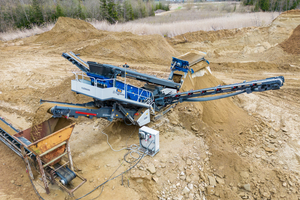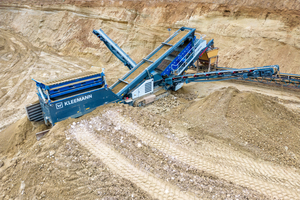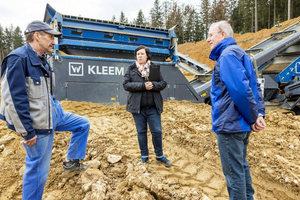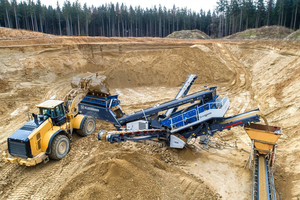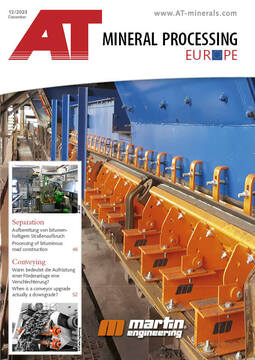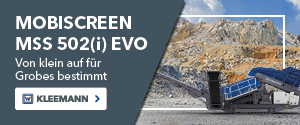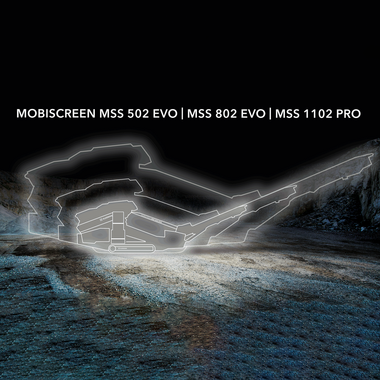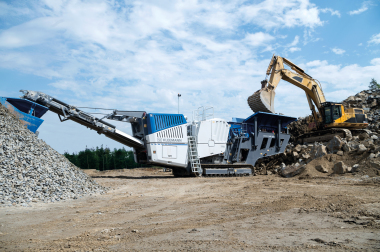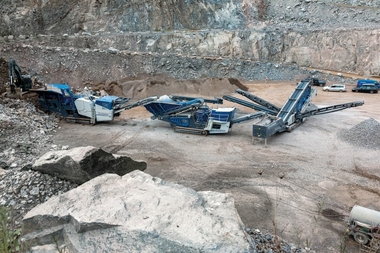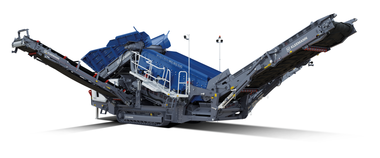Sustainable solution with screening machine MOBISCREEN MSC 702i EVO
Effective solution and climate-friendly operation
After a search for an efficient solution for separating the grain sizes, the operating company decided on the MOBI-SCREEN MSC 702i EVO with Dual Power. On the one hand, the screening machine has a wide, large screening surface that can deliver a very high output. On the other hand, Kleemann provides an option for all-electric operation of the machine – a future-oriented drive system that works on site without CO2 emissions: a positive feature for the environmental balance and quality assurance. To guarantee the power supply on site, the company built a transformer station that accompanies the machine, which is moved 2 to 3 times a year.
Demonstration of the new acquisition impresses
The new acquisition is the first machine in the operating company with an electric drive. Achim Haßdenteufel, Section Manager at Emil Steidle GmbH & Co. KG, and his team were already thrilled with the machine’s performance during the first test run. “We looked at different machines, tested them on site and compared the output. Our material here is very specific. We have a lot of clay in the raw sand that clogs the screens,” said Haßdenteufel. And Facility Manager Walter Kieper adds: “The machine has an impressive output. Everything can be operated very conveniently by remote control. Although our employees, who have been used to control via hydraulic levers up to now, had to reorientate, they quickly managed to cope with the digital display. Everything is clearly arranged and it has an intuitive design.”
Details make the difference
The refined technical details of the MSC 702i EVO meet the high demands of the material. The configuration of the belts on the machine, for example, can be mirrored. The fine grain conveyor and middle grain conveyor can therefore be installed either on the right or left and the travel distance of the wheel loader can be kept as short as possible. This also reduces the power consumption and wear on the vehicles.
The MOBISCREEN MSC 702i EVO is equipped with a vibrating slotted grate. Large sand stones can therefore be separated in advance and the machine can be loaded with a 0 to 50 mm feed size. The upper deck is used as a relief deck; the second deck defines the target grain size. The stepless setting option of the belt speed contributes to energy efficiency: As the screening process in the sand pit merges the discharge of the middle grain conveyor and fine grain conveyor, only one side discharge conveyor is actively operated. The speed of the second belt is throttled to save energy. The reduced speed is also an advantage when the feed material is very wet, as Michell Blasczyk from WIRTGEN DEUTSCHLAND Vertriebs- und Service GmbH explains: “Sand is not always the same. Depending on moisture content and properties, the covering, inclination angle, speed and many other factors must match exactly.”
During set-up, the operating company also placed their trust in support from the Kleemann experts – among other things, from specialist departments who prepared precise flow charts or the Kleemann laboratory that examined the material exactly in advance.
In an interview with Claudia Hizman, Marketing Kleemann, Facility Manager Walter Kieper and Section Manager Achim Haßdenteufel relate why Steidle decided on an electrically driven screening plant, how the infrastructure had to be converted and how the plant proved its value in practice.
Mr Kieper, what do you produce at the site here in Meßkirch-Rengetsweiler?
Walter Kieper: We extract around 100 t of sand an hour from the pit. Approximately 60 % of the sand is further processed in our plant in Krauchenwies. Here, it is cleaned and separated into even finer grain sizes. This high quality sand, which practically no longer contains clay, is used, for example, for stained glass production or for building materials such as plaster or adhesives. A part of the sand, however, is also delivered from here directly to customers and used, for example, for sports ground surfaces.
Mr Haßdenteufel, with the MOBISCREEN MSC 702i EVO with Dual Power Steidle now has its first all-electric plant in operation at its site here. How did you arrive at this decision?
Achim Haßdenteufel: There were several reasons. Firstly, there are signs that the availability of fossil fuels in the future will be limited and will therefore gradually become more expensive. Of course, in the company we constantly consider how we can improve our position. Secondly, our electric drives make a contribution to lowering CO₂ emissions. All things considered, we regard this as an investment in the future. As far as the subject of energy is concerned, Steidle was always a future-oriented company. Even 50 years ago we had steam power plants and today we have numerous solar surfaces. In our plant in Krauchenwies, we produce wood pellets in co-operation with the company Schellinger. Our biomass heating power plant has been located here since 2008. As you can see, Steidle has occupied itself with the subjects of energy and sustainability for decades.
This means that you will increasingly place your trust in electric drives in the future, also for other plants and machines?
Achim Haßdenteufel: More and more plants, vehicles and machines on the market are using an electric drive. The choice between the acquisition of an electric drive or combustion engine in future will be easy to make. In the medium-to-long term we want to obtain our power from a photovoltaic system at our site here. This will then be the ideal combination economically – electric drives plus self-generated electricity. Here, the pilot system of a forest PV system is currently being set up for research purposes beside the quartz sand plant. We are working on this together with the Forest Research Institute Baden-Württemberg and the Forestry Department of the District Office in Sigmaringen. Our Managing Director, Hans Steidle, came up with the idea of the pilot system. We then went to the District Office where the initiative was welcomed and supported. Once we achieve positive results with the forest PV system, we want to set up several of them so that we can generate the required power ourselves. After all, we have enough space on our site.
For the new Kleemann screening plant MOBISCREEN MSC 702i EVO with Dual Power, however, you still have to rely on purchased electricity. What infrastructure does this require?
Achim Haßdenteufel: The power supply required the development of a comprehensive concept, which we planned and implemented together with an external service provider. If we had fed the power supply via a 400 v feed directly into the machine, then the long cable section would have required a cable cross-section that is far too large. This would have been too unmanageable and difficult to handle; on the other hand, a cable with such a cross-section is far too expensive. This is why we now work with two transformers. In the first transformer, the power is transformed from 400 to 990 v. This permits a thinner cross-section, whereby the cable becomes more manageable and slightly more cost-effective.
The second transformer was positioned directly beside the screening plant; it transforms the 990 v back to 400 v, which are then fed to the machine. As we move the plant two to three times a year, however, the second transformer block had to have a mobile design. This required a bit of tinkering, but now we have found a very good solution. This system now permits us to move the machine 1.2 km. Up to now, we only really used the diesel generator to move the plant and for initial folding of the belts. Operation with the power supply works perfectly.
From your perspective, does the move away from fossil fuel result in further advantages of the electric drive?
Walter Kieper: The machine really does run very quietly, which, of course, primarily benefits the operator. As we have no residents in the direct vicinity and the machine also sits “in a pit”, the sound intensity is not really a critical factor. A further advantage of the electric drive is that the machine comes to an immediately standstill after it is switched off. In contrast to this, a diesel engine has an after-running time and has a long cooling-down phase. When the belt is stationary, a diesel engine continues running to prevent damage. This is now no longer necessary thanks to the electric drive.
The switch to an electric drive is state-aided. So you benefited from subsidies in this case?
Achim Haßdenteufel: Yes, this is of course a pleasant side-effect: The additional costs of the electric conversion are subsidised by BAFA (Federal Office of Economics and Export Control).
The plant is not only the first electric plant, but also the first Kleemann plant in the company. Why did you decide on Kleemann?
Achim Haßdenteufel: We looked at different plants, tested them on site and compared the output. Our material here is very specific. We have a lot of clay in the raw sand that clogs the screens. In the end, the Kleemann plant and the good advice convinced us. However, basically it was a classic price-performance decision.
Are there any other specific machine requirements related to the very special material?
Walter Kieper: Now at the start it will take some time until the plant settings have been optimised. I’m still testing and tinkering, for example, to find out how wear on the lower harp screen can be reduced. The screen surface in the lower deck has to be changed every 6 weeks. Of course the upper decks with a wire thickness of around 10 mm last considerably longer. It will take some time until the settings are perfect, but here I’m also counting on the support from the Kleemann consultant.

